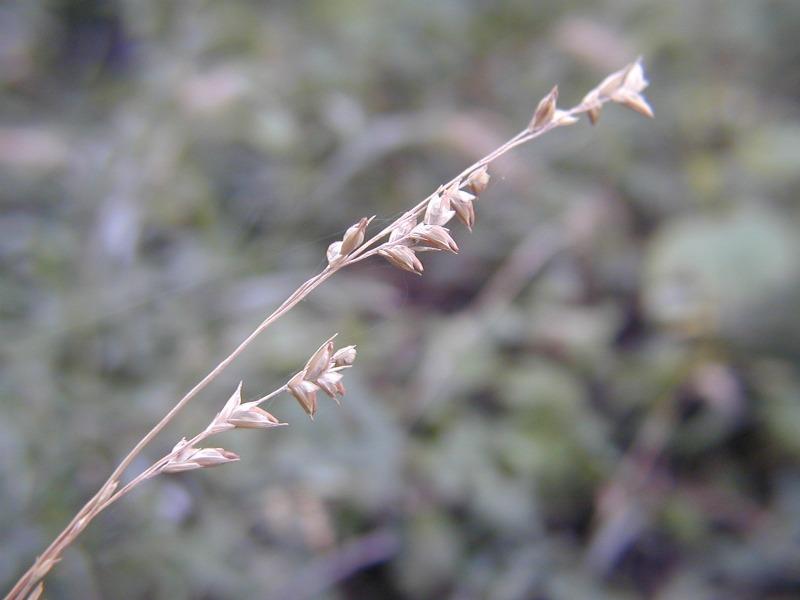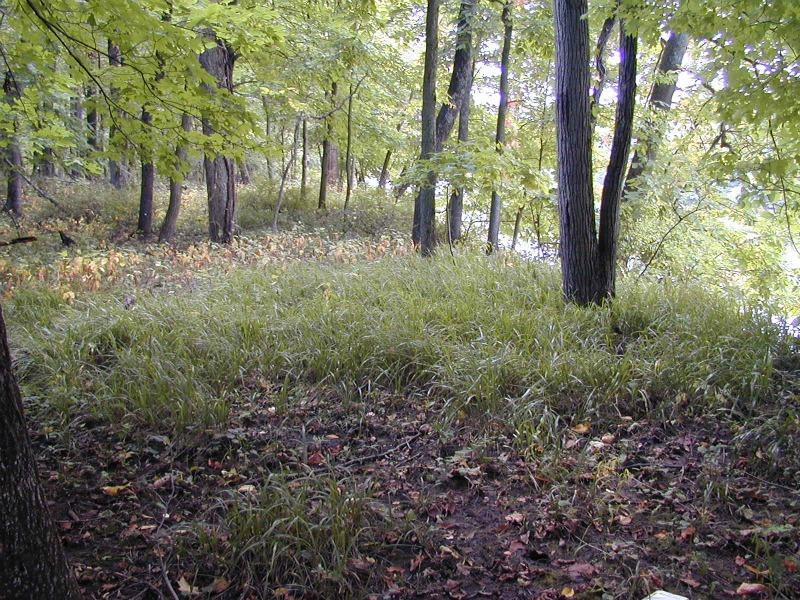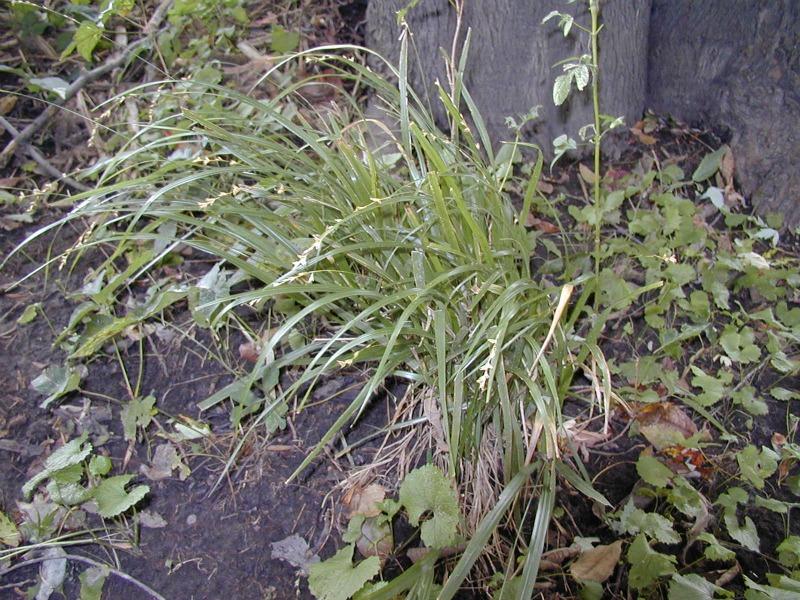Western Beakgrain
Diarrhena obovata (Gleason) Brandenburg
- Class
- Monocotyledoneae (Monocots)
- Family
- Poaceae (Grass Family)
- State Protection
- Threatened
Listed as Threatened by New York State: likely to become Endangered in the foreseeable future. For animals, taking, importation, transportation, or possession is prohibited, except under license or permit. For plants, removal or damage without the consent of the landowner is prohibited.
- Federal Protection
- Not Listed
- State Conservation Status Rank
- S2
Imperiled in New York - Very vulnerable to disappearing from New York due to rarity or other factors; typically 6 to 20 populations or locations in New York, very few individuals, very restricted range, few remaining acres (or miles of stream), and/or steep declines.
- Global Conservation Status Rank
- G4G5
Apparently or Demonstrably Secure globally - Uncommon to common in the world, but not rare; usually widespread, but may be rare in some parts of its range; possibly some cause for long-term concern due to declines or other factors. More information is needed to assign either G4 or G5.
Summary
Did you know?
This species is at its northeastern limit of distribution in New York. The genus name does not derive from any kind of malady but rather from the two stamens in its flower (di=twice and arrhen=male).
State Ranking Justification
There are two known populations of this plant first reported within New York in 1993. While there are only two populations, the state rank is based more on the total number and extent of plants numbering in the tens of thousands along a large part of the Wallkill River where it is the dominant plant in some sections.
Short-term Trends
This is a recent addition to our flora and new populations have been found. Plant numbers seem to be stable.
Long-term Trends
Long-term trends have not yet been established.
Conservation and Management
Threats
There are no threats at the present time but this floodplain species likely requires natural fluctuations in water levels so any manipulation that reduces these fluctuations could threaten it. As a floodplain species, it is often found with some potentially invasive plants. So far, Diarrhena is able to compete very well within its limited distribution. In fact, it is the dominant plant in some sections along the Wallkill River.
Conservation Strategies and Management Practices
There are no management needs at this time.
Research Needs
We would like to know how and when this plant was established in New York.
Habitat
Habitat
A grass of floodplain forest and stream banks within the active agricultured Wallkill Valley (New York Natural Heritage Program 2004). Moist woods (Gleason and Cronquist 1991). Floodplain swamp forests, riverbanks and creek bottoms (Voss 1972). Shaded river banks and woods (Fernald 1970).
Associated Ecological Communities
- Floodplain forest
(guide)
A hardwood forest that occurs on mineral soils on low terraces of river floodplains and river deltas. These sites are characterized by their flood regime; low areas are annually flooded in spring, and high areas are flooded irregularly.
Associated Species
- Acer negundo
- Acer rubrum var. rubrum (common red maple)
- Acer saccharinum (silver maple)
- Ambrosia artemisiifolia (common ragweed)
- Carya cordiformis (bitternut hickory)
- Celtis occidentalis (northern hackberry)
- Impatiens pallida (pale jewelweed, pale touch-me-not)
- Laportea canadensis (wood-nettle)
- Leersia oryzoides (rice cut grass)
- Panicum clandestinum
- Platanus occidentalis (eastern sycamore)
- Polygonum virginianum
- Populus grandidentata (big-toothed aspen)
- Quercus coccinea (scarlet oak)
Range
New York State Distribution
Only recently documented within New York along the Shawangunk Kill and Wall Kill, there is some debate regarding whether or not this plant has spread naturally into New York or if it was brought in with some agricultural seed. It appears with many other native species in some of the higher quality floodplain forests located along these streams.
Global Distribution
A grass that is generally considered a western plant with the center of its range described as Indiana to South Dakota, Kansas, and Texas. Disjunct populations have been reported from New York, Maryland, Delaware, and Virginia.
Identification Comments
General Description
Diarrhena is an attractive grass that forms clumps of dark green arching leaves about 1 meter tall. They may form large colonies along the floodplain. The fruiting stems are about as long as the leaves with groups of 3-5 small tan-colored spikelets at the end of the arching branches. When they are mature each flower has a rather large bowling pin-shaped grain sticking out of it.
Identifying Characteristics
A large grained grass with stems up to 1.2 meters tall and a scabrous panicle. The spikelets have 3-5 flowers with disarticulating occurring above the glumes. Mature spikelets are firm with large protruding bottle-shaped grains. The first glume is 1.9-2.8 mm and the second glume is 2.4-4.3 mm. The lemmas are glabrous, 5.2-6.8 mm long, and abruptly rounded into a short cusp. The callus is glabrous.
Best Life Stage for Proper Identification
Plants with mature fruit are best for proper identification, although one could probably identify this in flower. If this plant is found along a stream corridor, consider searching the entire corridor as many more plants are likely. A stem with leaves and mature fruit should be collected to verify the identity.
Similar Species
A very unique looking grass that is not likely to be confused with anything else we have in New York. Diarrhena americana var. americana is a Midwestern species that is closely related to D. obovata. Diarrhena americana var. americana has a hairy panicle, the first glume is 2.2-4 mm, the second is 4-5.4 mm, the lemmas are 7-10 mm long and ovate with an acuminate tip, and the callus (except of the first lemma) is more or less hairy.
Best Time to See
This grass flowers in mid-summer and fruits persist to late fall. Surveys should be conducted in late August to October.
- Flowering
- Fruiting
The time of year you would expect to find Western Beakgrain flowering and fruiting in New York.
Western Beakgrain Images
Taxonomy
Western Beakgrain
Diarrhena obovata (Gleason) Brandenburg
- Kingdom Plantae
- Phylum Anthophyta
- Class Monocotyledoneae
(Monocots)
- Order Cyperales
- Family Poaceae (Grass Family)
- Order Cyperales
- Class Monocotyledoneae
(Monocots)
- Phylum Anthophyta
Additional Common Names
- American Beakgrain
- Beakgrain
- Beakgrass
Synonyms
- Diarrhena americana var. obovata Gleason
Additional Resources
Best Identification Reference
Gleason, Henry A. and A. Cronquist. 1991. Manual of Vascular Plants of Northeastern United States and Adjacent Canada. The New York Botanical Garden, Bronx, New York. 910 pp.
Other References
Fernald, M.L. 1950. Gray's manual of botany. 8th edition. D. Van Nostrand, New York. 1632 pp.
Holmgren, Noel. 1998. The Illustrated Companion to Gleason and Cronquist's Manual. Illustrations of the Vascular Plants of Northeastern United States and Adjacent Canada. The New York Botanical Garden, Bronx, New York.
Mitchell, Richard S. and Gordon C. Tucker. 1997. Revised Checklist of New York State Plants. Contributions to a Flora of New York State. Checklist IV. Bulletin No. 490. New York State Museum. Albany, NY. 400 pp.
New York Natural Heritage Program. 2010. Biotics database. New York Natural Heritage Program. New York State Department of Environmental Conservation. Albany, NY.
New York Natural Heritage Program. 2024. New York Natural Heritage Program Databases. Albany, NY.
Reschke, Carol. 1990. Ecological communities of New York State. New York Natural Heritage Program, New York State Department of Environmental Conservation. Latham, NY. 96 pp. plus xi.
Voss, E.G. 1972. Michigan Flora, Part I. Gymnosperms and Monocots. Cranbrook Institute of Science Bulletin 55 and the University of Michigan Herbarium. Ann Arbor. 488 pp.
Weldy, T. and D. Werier. 2010. New York flora atlas. [S.M. Landry, K.N. Campbell, and L.D. Mabe (original application development), Florida Center for Community Design and Research http://www.fccdr.usf.edu/. University of South Florida http://www.usf.edu/]. New York Flora Association http://newyork.plantatlas.usf.edu/, Albany, New York
Links
About This Guide
Information for this guide was last updated on: September 8, 2004
Please cite this page as:
New York Natural Heritage Program. 2024.
Online Conservation Guide for
Diarrhena obovata.
Available from: https://guides.nynhp.org/beakgrass/.
Accessed July 26, 2024.



